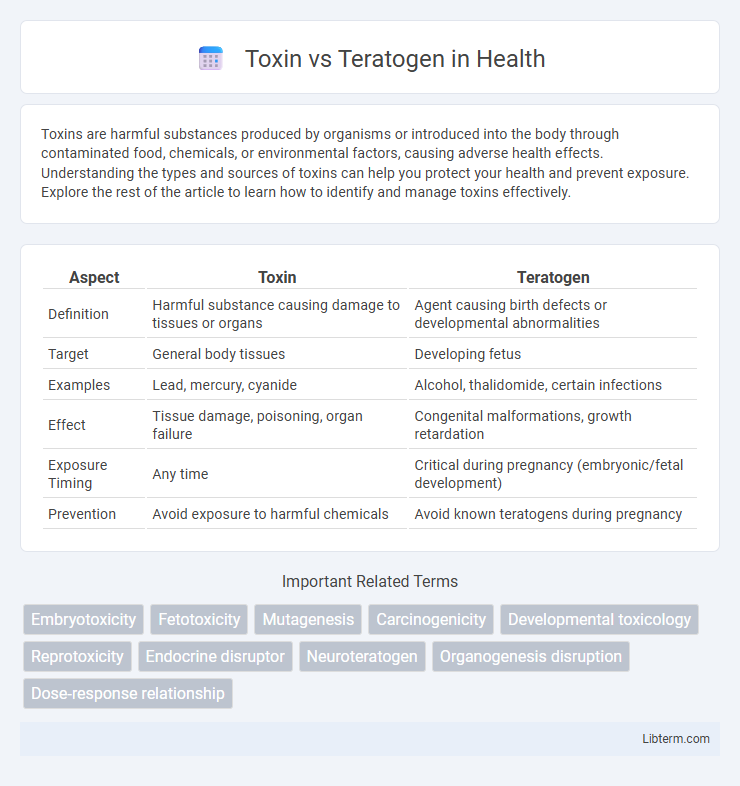Toxins are harmful substances produced by organisms or introduced into the body through contaminated food, chemicals, or environmental factors, causing adverse health effects. Understanding the types and sources of toxins can help you protect your health and prevent exposure. Explore the rest of the article to learn how to identify and manage toxins effectively.
Table of Comparison
| Aspect | Toxin | Teratogen |
|---|---|---|
| Definition | Harmful substance causing damage to tissues or organs | Agent causing birth defects or developmental abnormalities |
| Target | General body tissues | Developing fetus |
| Examples | Lead, mercury, cyanide | Alcohol, thalidomide, certain infections |
| Effect | Tissue damage, poisoning, organ failure | Congenital malformations, growth retardation |
| Exposure Timing | Any time | Critical during pregnancy (embryonic/fetal development) |
| Prevention | Avoid exposure to harmful chemicals | Avoid known teratogens during pregnancy |
Introduction to Toxins and Teratogens
Toxins are harmful substances produced by living organisms that can cause damage to cells and tissues upon exposure. Teratogens are a specific category of agents, including chemicals, drugs, and environmental factors, that disrupt fetal development and result in congenital abnormalities. Understanding the mechanisms of toxicity and teratogenicity is essential for assessing risks posed by these agents during pregnancy.
Defining Toxins: Origins and Effects
Toxins are poisonous substances produced naturally by living organisms such as plants, animals, and bacteria, impacting human health through ingestion, inhalation, or skin absorption. These biologically derived compounds can disrupt cellular functions, cause organ damage, or trigger immune responses, varying widely in potency and mechanism. Unlike synthetic chemicals, toxins originate from natural metabolic processes and are often studied for their ecological and medical significance.
What Are Teratogens? Mechanisms and Impact
Teratogens are agents that cause developmental malformations in an embryo or fetus by interfering with cell division, differentiation, or growth during critical periods of gestation. Common teratogens include certain drugs, environmental chemicals, infections, and radiation, which disrupt normal gene expression or damage cellular structures resulting in congenital abnormalities. Understanding the mechanisms of teratogenesis highlights the significance of timing and dose, as exposure during organogenesis leads to the most severe structural defects.
Key Differences Between Toxins and Teratogens
Toxins are harmful substances that can cause cellular damage and physiological dysfunction in organisms, while teratogens specifically disrupt fetal development leading to congenital malformations or birth defects. Toxins affect multiple organ systems at various exposure levels, whereas teratogens impact embryonic or fetal growth primarily during critical windows of prenatal development. Understanding these distinctions is crucial for risk assessment in toxicology and developmental biology.
Common Sources of Toxins
Common sources of toxins include industrial chemicals, pesticides, heavy metals like lead and mercury, and contaminated food or water. These substances can cause harmful effects on human health depending on the level and duration of exposure. Unlike teratogens, which specifically cause developmental abnormalities in embryos, toxins have broader impacts affecting multiple organ systems.
Typical Teratogens in the Environment
Typical teratogens in the environment include chemicals such as lead, mercury, and certain pesticides, which disrupt fetal development and cause congenital abnormalities. Unlike general toxins that harm any living tissue, teratogens specifically interfere with embryonic growth during critical periods of pregnancy. Exposure to these environmental teratogens through contaminated air, water, or soil significantly raises the risk of birth defects and developmental delays.
How Toxins Affect Human Health
Toxins, harmful substances produced by living organisms, disrupt human health by damaging cells, interfering with metabolic processes, and triggering immune responses that can lead to illness or organ failure. They may cause acute poisoning or chronic conditions such as neurological disorders, respiratory issues, or cancers depending on exposure level and toxin type. Unlike teratogens, which specifically cause developmental abnormalities in embryos, toxins affect general physiological functions across all ages.
Effects of Teratogens on Fetal Development
Teratogens cause structural and functional abnormalities in fetal development by disrupting normal cell differentiation, growth, and organ formation during critical periods of gestation. Exposure to teratogens such as alcohol, certain medications, or infections can result in congenital malformations, neurodevelopmental deficits, and growth retardation. The severity of teratogenic effects depends on the timing, dosage, and genetic susceptibility of the fetus.
Strategies for Reducing Toxin and Teratogen Exposure
Reducing exposure to toxins and teratogens involves minimizing contact with harmful chemicals such as heavy metals, pesticides, and alcohol, particularly during pregnancy. Strategies include using air and water purification systems, choosing organic and non-toxic products, and following workplace safety guidelines to avoid hazardous substances. Public health interventions focus on education about risk factors and promoting policies that limit environmental contamination and regulate industrial emissions.
Conclusion: Understanding Risks and Prevention
Toxins and teratogens both pose significant health risks, with toxins causing general harm to biological systems while teratogens specifically disrupt fetal development, leading to congenital abnormalities. Identifying and minimizing exposure to these harmful agents through environmental control, proper medication use, and public health education is essential for effective prevention. Comprehensive understanding of their mechanisms enables targeted strategies to reduce adverse health outcomes in both individuals and populations.
Toxin Infographic

 libterm.com
libterm.com